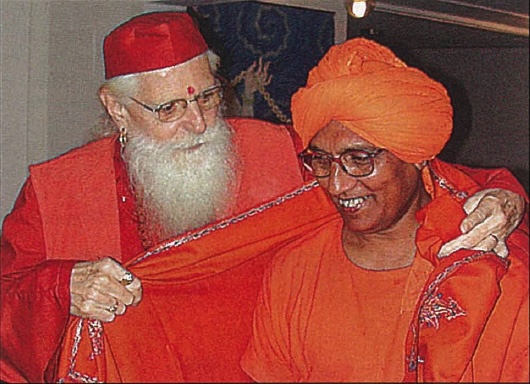By Swami Agnivesh
I came to know about Hinduism Today and the mission of Satguru Sivaya Subramuniyaswami six or seven years ago through a friend who lives in Switzerland. He gave me some literature about the magazine. Ever since I have been off and on looking at Hinduism Today and trying to find out more about Gurudeva’s great work. I finally met him at the Millennium Peace Summit of World Religious and Spiritual Leaders in New York in August, 2001, along with his monks, friends and colleagues. I was very much impressed by their serenity and the way they conducted themselves at the summit. Later on, when I was visiting Australia, New Zealand and Hawaii, I was able to meet Gurudeva at his Kauai ashram, the abode of peace.
That was a very great experience for me. The whole ashram radiated with his philosophy and concept of Hindu renaissance. I was impressed not only by the natural beautyÑI can say this is the rarest natural place in the whole world where easily you can have peace of mindÑbut I was also impressed by the devotion and dedication of Gurudeva himself and the fourteen sannyasin monks living there. I was impressed by each one of them. Each of them carried with him a great mission to bring out the best in Hinduism and to transmit it to the people the world over.
I was thrilled when Gurudeva personally greeted me, gave me a shawl and embraced me. He was very affectionate. I was moved and very much touched by his gesture. I was an ordinary visitor there, yet he could not only find time to meet me, but was personally attentive. He discussed with me as to how we could collaborate to bring forth the real Vedic light. People have been denied access to the Vedas over centuriesÑnumber one, by some medieval pundits. There are so many wrong interpretations, perverse interpretations, which have done a lot of disservice. Gurudeva was very thrilled that we would be able to collaborate and work together.
I was taken around the whole ashram. I had lunch there and long discussions with the other swamis. The whole atmosphere exuded a type of culture which I had not seen anywhere. The most thrilling aspect for me and the most reassuring aspect of the ashram and the sannyasins led by Gurudeva was that there are some great sannyasins who were not born Hindus. And yet they had taken upon themselves the rigors of a sannyasin, not only in terms of austere lifestyle but also scholarship and meditation. And I could see that for the first time in history an organized attempt was made under the leadership of Gurudeva to break this concept that Hindus are there only by birth. For several centuries in our country, India, we have had this nauseating concept that you can only be born as a Hindu, and that there is no way that you can become a Hindu. The Satguru challenged this and displayed to the world that it can be done, and that it can be done in a very, very glorious way. They laid the foundation for renaissance, Satguru and his colleagues.
Normally in an ashram in India the guru is kept at a distance. But here Gurudeva freely mixes with you. I was overwhelmed by the whole atmosphere. I very much cherish my few hours spent there. I would like to go back. One of his sannyasins who works on Hinduism Today briefed Gurudeva about what generally is the public opinion about me and my work. Gurudeva said, “He is doing a good work and taking a lot of abuse in the process. Therefore, I will support him wholeheartedly.” Now, this is a very bold statement.
Normally, the swamis and gurus keep aloof from the world. They do not want to be involved in the worldly things. Now, this great swami had learned about the use of fly ash to make concrete, by replacing part of the cement [used for the massive foundation of Iraivan temple]. When I told him that I work among brick-kiln workers, bonded laborers and stone quarry workers, he wanted me to be in touch with that environmentally friendly technology [which could be used in brick making]. Fly ash is a waste product of power plants and causes much pollution in India. Gurudeva was very particular that I should learn about it. Subsequently, a few months later, he sent me by e-mail more information. This aspect of Satguru impressed me very much. He was very much worldly. He was very environmentally friendly. He was for new technology which helps humankind to live better. His spirituality was not confined to japa and chanting but it was very much a part of the world as well. He wanted his spirituality to resonate outside also. That is what I consider to be social spirituality. This spirituality not only takes care of the inside of a person but his outside as well. This was very great of him.
I am very sure that he has made a breakthrough in this age-old concept that a Hindu is only born and that there is no way you can become a Hindu. By himself becoming a Hindu and a sannyasin, he has challenged the obnoxious caste system. Because if you are only born a Hindu, then obviously you are born into a caste. There is no way that you can get away from the caste system. He gave me a copy of his very fascinating book, How to Become a Hindu [published in India by Motilal Banarsidass]. He has opened the door for millions and millions worldwide to become Hindus in a scientific manner. I think it is a great tribute we should pay to Gurudeva, and I am sure people around him, who have worked with him, will carry forward the torch, and we will all be able to contribute to the dream and vision of Gurudeva.


